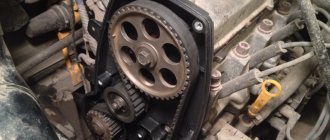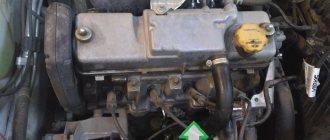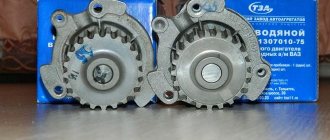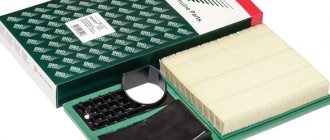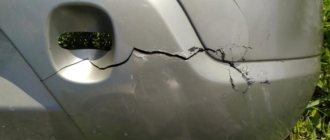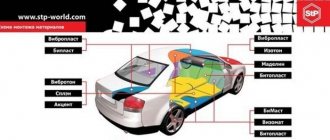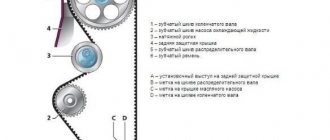So I was overtaken by the trouble of “falling” headlights, this happened in the second winter. I already knew how to repair it, I looked at several topics here about adding coolant to the hydraulic corrector. In the meantime, I raised the headlights manually and postponed the repair until warmer weather.
I liked this work most of all, everything is described in detail, so I took it into service, thanks to the author!
And so, about a month ago I took up this issue. For this you will need:
- syringe; - coolant.
Removing the corrector from the headlight
We cut off the tube in this place and then remove the rest of the tube from the corrector itself
Removed corrector and loaded syringe. The syringe was filled with antifreeze, which I have for refilling.
I made a bracket from a plate so that it would be convenient to pull out the corrector ball
And so, using the bracket we pull out the working part of the corrector
And pump antifreeze into it, about 1.5-2 cubes. Don't be afraid to press harder, the excess will come out on its own, but disconnect the syringe carefully, splashes are possible.
Next, we go to the car and connect the corrector tube, and then remove the bracket.
I put it in place and checked its operation, the antifreeze did not escape anywhere.
Result:
The headlight began to shine much higher than before the repair. The result is there, you can rejoice!)
We do the same with the second headlight, it doesn’t take much time.
After all the work, it is necessary to adjust the height of the headlights; I moved the corrector knob to almost the minimum position so that I could slightly release the headlights if something happened. Then, using manual adjustment, I set the height I need.
As I said earlier, I did it a month ago and so far during this time the height of the headlights has remained at the same level. The work itself is simple and easy; it can be done more than once and at any time. And you don’t need to buy a new hydraulic corrector.
MALFUNCTIONS OF THE ELECTROMECHANICAL CORRECTOR
An electric drive system is much more reliable than a hydraulic corrector, but it is not without its drawbacks.
Possible malfunctions:
- breaking off, chafing of wires, formation of oxides in connectors;
- wear of electric motor elements;
- burnout of circuit elements (for example, due to overvoltage in the machine’s on-board network or moisture entering the control unit housing). Faulty resistors can cause the corrector to operate incorrectly or only within a limited adjustment range. Often the problem is wear of the resistive tracks, which causes contact chatter. The ECU will constantly try to equalize the voltage, as a result of which the microcircuit elements fail due to overheating.
We will consider the process of diagnosing the electromechanical forced-action headlight range control. Diagnosing complex faults in automated systems that use ride height sensors requires much more specialized technical training.
CIRCUIT DIAGRAM
Before starting diagnostics, you should study the electrical diagram for connecting the gearmotors on your car.
Most often, 2 typical connection schemes are used:
- with 5-wire gearmotor connector. This connection method can be found not only in standard systems, but also in kits for installing an electrical corrector with your own hands (for example, EMKF 11);
- with a 3-wire connector for gearmotors (most often found on modern cars). Accordingly, one of the contacts will be “ground”, the second will be a constant “+”, and the third will be a signal wire.
Despite the different pinouts, the electric headlight corrector works on most cars according to a similar principle. The operating principle is based on a constant comparison of the voltage across two variable resistors. One of the resistors is connected to the headlight range control switch on the dashboard, and the other to the actual position sensor of the electric corrector rod. Comparing voltages with a differential amplifier allows you to realize voltage equalization in the event of a mismatch error. Thus, turning the switch on the dashboard causes the headlight range control motor to extend by a fixed distance.
Reasons for failure of the hydraulic regulator
When the driver notices that one or even both headlights do not respond to control, the symptom indicates that the device is not working. Common reasons:
- the working cylinder is jammed, one of the lamps does not turn;
- depressurized due to wear of sealing components;
- the rod and lever of the actuator are not fastened tightly enough;
- the connecting tubes are damaged, which caused a loss of tightness.
Violation of integrity leads to the fall of reflectors on both sides - they end up in the lowest position.
Damage to tubes in the hydraulic system occurs due to sudden temperature changes in the engine compartment.
There are several ways to deal with the problem that has arisen on the Lada Granta:
- replace the hydraulic regulator with an electric corrector;
- fill the working cylinders with antifreeze;
- replace faulty cylinders with plugs for headlights;
- install self-tapping bolts, fixing the reflectors.
Plugs or bolts will make the system functional but unregulated. Filling with antifreeze allows you to adjust the position, however, the measure still remains temporary, since then a full replacement will be required.
CHECKING POWER WITH A MULTIMETER
If you have not previously encountered diagnostics of electrical appliances, we recommend that you read the instructions for using a multimeter. The first thing you need to check is whether there is a constant “+” at the gearmotor connector and whether there is a “ground” on it. Also, in direct current measurement mode (DCV), connect the positive probe to the signal wire, and the negative probe to the ground pin.
When turned off, the voltage is minimal, while when the switch is rotated it should be from 3 to 10 V. Before checking, you must turn on the low beam headlights.
If “–” or “+” does not come into the chip, the same operation should be carried out with the connector connected to the control unit in the car interior. If power leaves the ECU chip, but does not reach the connector, then the problem is a broken wiring. If there is no power to the gearmotor at the connector, you should check the “ground” and “+” of the control unit itself. A situation where power comes to the unit, but the ECU does not react in any way to changing the position of the switch, indicates a malfunction inside the headlight range control unit.
It is not recommended to directly apply battery voltage to the terminals of the gear motor for a long time in order to check its performance. To correctly diagnose the electric drive, you should include a 10 kOhm trimmer resistor in the circuit.
Fog lights VAZ 2114 and VAZ 2115: what you need to know
So, in order to decide which PTF is better for the VAZ 2114 or 2115, it is worth noting that the choice must be approached responsibly. First of all, early versions of the VAZ 2114 were produced without fog lights, but subsequent “fourteenth” and similar “tags” may initially have standard PTFs.
If there are no fogs, in the second case there are still bumper plugs. This makes installation much easier. Let’s also add that many drivers of VAZ 2114 or 2115 are simply not satisfied with the standard VAZ fog lights. One way or another, owners are looking for the best option for both installation and replacement. Let's figure it out.
What does a hydraulic corrector consist of and how does it work?
The hydraulic device, thanks to which you can adjust the angle of the light beam from the interior, consists of the following main parts:
- master cylinder located under the dashboard;
- working cylinders, one on each headlamp;
- tubes connecting the above devices.
Hydrocorrector of Lada Granta headlights
In addition, there is a mode switch on the instrument panel, with which the driver changes the pressure in the master cylinder.
The hydraulic corrector system is closed and at the same time sealed (normal). The changed pressure is transmitted through the tubes to the working cylinders. This leads to a change in the position of the pistons and the rods connected to them. They use a special lever mechanism to influence the angle of rotation of the reflector. This is the operating principle of the hydraulic headlight adjuster for the Lada Granta.
Switch for adjusting the headlight beam angle
The electric corrector differs in that the desired position of the lampshades is ensured by mechanisms powered by on-board electricity. Their operation is not affected by changes in ambient temperature, so they are much more reliable than hydraulic devices. Their only “minus” is the cost, which is several times higher.
How to turn on near or far
The light switch on the Grant is located below the left of the steering wheel - similar to the tenth family.
Switching the handle clockwise gives the headlight and low beam modes.
To turn on the high beam:
- turn the light knob to the extreme right clockwise - the low beam will turn on;
- push the left steering column switch forward (the one that controls the turn signals);
- your high beam will light up - and a blue headlight icon will appear on the panel - keep an eye on it so as not to leave the car with high beam when it is no longer needed.
Diagnostics and adjustment of optical elements on Grant
How to remove the headlights yourself, how to raise the optics, how to adjust the position of the low and high beam lamps? Let's start with the issue of diagnostics and settings; the methods described below are relevant for many car models. Fret Grants are equipped with lens optics and halogen bulbs. Using the hydraulic corrector, you can adjust the light of the left and right headlights yourself; if necessary, you can activate the delay function for turning off the lighting after activating the ignition after 45 seconds. As for the rear lights, of course, they do not need adjustment.
To adjust the light output, you will need a set of wrenches, as well as a Phillips-head screwdriver. To properly adjust the headlights, the spare wheel must be in place, in the niche under the luggage compartment, and it is also advisable to fill the fuel tank with a full tank. These nuances will ensure maximum load on the car; for more accurate diagnostics, the car should be placed on a horizontal surface.
How to adjust optics:
- First of all, you need to start the power unit of the car and wait a few minutes until it idles. The car itself should be set to the parking brake.
- Check the tire pressure level - if necessary, the tires should be inflated.
- It is advisable that there is a smooth and light wall in front of the car, but if this is not possible, then a sheet of plywood or drywall should be installed about three meters in front of the car. Its height should be about 2 meters. Markings should be applied to the wall itself.
- Next, a load weighing about 75 kg is placed on the driver's seat to simulate the driver being behind the wheel. This will align the low beam line from the light sources.
- To prevent possible vibrations from the car body and shock absorbers, the car needs to be rocked slightly from side to side.
- Next, the electric corrector must be installed in the position of one person in the car, corresponding to the load in the driver’s seat.
- After this, the low beam is activated and the lights are adjusted - separately left and right. A corrector is used for adjustment. In accordance with the above diagram, the lighting flux from the lamps should be similar to that shown in the figure.
Instructions for setting up the headlight
A special thumbwheel is used to adjust the lighting flux horizontally, and a hexagonal screw is used to adjust the lighting vertically. If necessary, you can raise or lower the lighting from the optics, for example, if there is a heavy load in the trunk and the front part is raised. When the low beam adjustment is completed, it is necessary to perform a test drive to check the quality and correctness of the procedure. You must not allow the light from your optics to blind oncoming drivers.
Procedure for adjusting the headlights of a Lada Granta with your own hands
Tool preparation: screwdriver, hexagon.
- Installation of the machine within the perimeter of the repair area, on a flat platform.
- Checking the tire pressure, the presence of a spare tire in the trunk, the weight of the load on the driver's seat is 75.0 kg.
- Adjustment / correction of the light beam at a distance of no more than 3.0 meters from the wall.
- Check the illumination angle of each headlight one by one.
- Completion of work, testing for serviceability and accuracy of lighting.
Hydraulic corrector malfunction
In terms of its design, the corrector is a fairly simple device, consisting of a main cylinder, as well as two additional ones - one for each headlight. These cylinders are connected to each other through special tubes. On the center console of the Lada Granta there is a corrector control, which is used to adjust the optics. When the driver presses the corrector handle, the pressure level in the main cylinder changes - it is subsequently transmitted to the working cylinders. Due to the forces acting on the reflector piston, the angle of the optics changes.
If we are talking about an electric corrector, then in this case the option of transmitting force is carried out thanks to special motors. These devices are powered from the vehicle's electrical network. In practice, such devices have proven to be more resistant to temperature changes, in contrast to hydraulic correctors. Accordingly, the cost of the former is also higher.
Replacing the hydraulic corrector with a similar device
If the corrector does not work, then it will be necessary to either replace or repair the device, and the second option, as practice shows, is less appropriate. The reason for the repair usually lies in the jamming of the cylinder or a violation of the tightness of the system, in particular, we are talking about rupture of the sealing components or damage to the pipes.
How to replace the hydraulic corrector with a similar device:
- First, you need to unscrew the nut from the inside, and also remove the handle of the device itself to free the main cylinder of the system.
- The cylinder itself is removed after release.
- Next, other cylinders are dismantled, as well as the pipes through which pressure is transmitted.
- When these steps are completed, the entire structure is removed from the technological hole in the cabin.
- The procedure for installing a new corrector is performed in the reverse order (the author of the video is Romanych).
Replacing a hydraulic corrector with an electric one
As for replacing a hydraulic device with an electric one, in this case the replacement procedure looks similar. The device is dismantled and removed, and instead of the cylinders, electrical analogues of the devices are mounted. After completing these steps, the positive wire of the system must be connected to terminal number 20, and the negative wire must be connected to ground, that is, the car body. All connecting pipes should be replaced with wiring, and at the final stage, power from the device should be connected to the battery. After this, you should carefully check everything to see if the system is working correctly.
Expert answer
If you know how to remove correctors, then do it at your leisure. We will not repair them here, nor will we change them. Instead, we use one trick. Carefully study all the photos, and then get to work.
- Carefully remove, and if necessary, first bite off both hoses on each module. There will be liquid inside, it is poisonous;
Bite off hydraulic corrector hoses on the left headlight
Our self-tapping screw puts pressure on the piston, and it must be screwed in at an angle. This is the trick.
Height adjustment
If necessary, carry out additional adjustments. To do this you need a 6mm hex key. The adjusting screw in the Grant is fixed above the corrector module, which must be installed in place.
Vertical direction control
The setup itself is carried out according to standard methods. But we will assume that the “side regulators” are in the correct position. Then the procedure will be simplified:
- We move 5 meters away from the wall;
- We ensure that the upper horizontal border is at a distance of 52-53 cm from the ground. There is no need to go any higher - you will blind oncoming traffic.
Ideas for tuning headlights and their implementation
How can you tune the optics in the Lada Grant:
- Buy and install tuned optics. This option is one of the most expensive in terms of cost, however, it is considered the most effective. Tuned headlights will look really “cool”.
- Install eyelashes. This option is the cheapest in terms of implementation. You can purchase ready-made eyelashes in stores or online, which you just need to put on your car after first cleaning and degreasing the glass surface. If necessary, you can build eyelashes yourself; this will allow you to get a more original product, because you yourself can choose the appropriate shape. Eyelashes can be made from fiberglass, plastic or LEDs.
- Install new light bulbs - diodes or gas-discharge, that is, xenon. This option will not only improve the appearance of the car, but also provide better road lighting.
- Tint the headlights; for this purpose you can use a special film or tinting varnish. Please note that tinting may make the lighting worse, so you may need to install brighter lamps in addition.
Photo gallery “Tuned headlights”
Instructions for replacing parts
To replace the headlight hydraulic corrector on a Lada Granta car, you will need a wrench (head 21). Algorithm of actions:
- The adjustment knob on the dashboard is removed. There is a nut behind it that can be unscrewed with a knob. Afterwards you can pull out the main cylinder.
- Under the hood, the clamps holding the hydraulic mechanisms are pressed out. To pull them out, you need to turn the cylinders counterclockwise.
- The connecting tubes are secured with clamps having screw clamps. They need to be unfastened and brought into the car interior using the hole previously hidden by the seal.
After dismantling the old device, a replacement should be installed.
Installation of both hydraulic and electrical correctors is carried out through the vehicle interior. First, the device is pulled through the hole in the shield, then mounted in its usual place.
To electric
A more reliable and attractive electric headlight corrector on the Lada Granta is installed as follows:
- Before installing the headlight electric corrector, it is necessary to dismantle the failed device - first by disconnecting the main cylinder, then by disconnecting the hydraulics and leading the pipes through the passenger compartment.
- The negative terminal is disconnected from the battery.
- Electrical mechanisms are located where the working cylinders were installed. If the O-rings are worn out, they are replaced.
- The negative wire is connected to ground, the positive wire is connected to terminal 20.
- The wiring runs in the space previously occupied by connecting pipes.
The corrector lever is dismantled when installing the element.
Having finished with the wiring, you need to return the terminal to negative. The performance of the new system must be tested.
To hydraulic
If the owner is satisfied with the hydraulics, then replacing the headlight hydraulic corrector on the Grant is done in the same way:
- the old system is dismantled, connecting pipes are removed;
- new elements are installed in the same way in place of failed elements;
- O-rings are checked;
- Full testing is carried out.
There is no need to disconnect the battery when installing hydraulics to replace damaged correctors.


